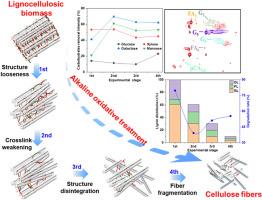温和条件下木质纤维素生物质在分子氧碱性氧化分馏过程中的降解特性
IF 6.2
2区 工程技术
Q2 ENERGY & FUELS
引用次数: 0
摘要
利用氧气对木质纤维素生物质进行碱性氧化分馏以获得木质素组分和富含纤维素的底物是最有前途的方法之一。本研究通过对木屑进行四种间歇碱性氧化处理,系统研究了木屑在不同阶段对碳水化合物和木质素的去除过程和降解产物,特别是通过GPC、FTIR和2D-HSQC揭示了提取木质素的分子结构特征。经过4次处理,逐渐提取出96.3%的木质素、93.5%的木糖、97.6%的半乳糖和93.4%的甘露糖,得到含葡萄糖84.1%的纤维固体。木屑在碱性氧化分馏过程中经历了结构松动、交联弱化、结构崩解和纤维破碎四个阶段。木糖、半乳糖和甘露糖的去除率先升高后降低,在第2次处理时达到峰值,分别为53.7%、69.6和61.0%。葡萄糖去除强度呈现先降低后显著增加的趋势,在第3次处理时达到了7.2%的低点。第1阶段木质素去除率和降解率最高,第3阶段木质素去除率最高。提取的木质素被氧化解聚成酸不溶性木质素片段(PL, 300-100,000 Da)和酸溶性木质素片段(ASL, 150-600 Da),其中ASL比PL含有更多的β-芳基醚和树脂醇键,部分碳水化合物和木质素发生严重的氧化降解,生成大量有机酸。这些结果有助于定量和定性地了解碱性氧化处理过程中木质素和碳水化合物的提取过程。本文章由计算机程序翻译,如有差异,请以英文原文为准。

Degradation characteristics of the lignocellulosic biomass during alkaline oxidative fractionation using molecular oxygen under mild conditions
Alkaline oxidative fractionation of lignocellulosic biomass using O2 to obtain lignin fraction and cellulose-rich substrate is one of the most promising strategies. This study systematically investigated the removal process and degradation products of carbohydrates and lignin at different stages through four intermittent alkaline oxidative treatments of sawdust, particularly revealing the molecular structural characteristics of extracted lignin through GPC, FTIR, and 2D-HSQC. After 4 treatments, 96.3 % of lignin, 93.5 % of xylose, 97.6 % of galactose, and 93.4 % of mannose were gradually extracted, resulting in a fiber solid containing 84.1 % glucose. The sawdust underwent four stages of structure looseness, crosslink weakening, structure disintegration, and fiber fragmentation during alkaline oxidative fractionation. The removal intensity of xylose, galactose, and mannose first increased and then decreased, reaching a peak of 53.7, 69.6, and 61.0 % respectively in the 2nd treatment. The glucose removal intensity followed a trend of first decreasing and then significantly increasing, having a low point of 7.2 % in the 3rd treatment. The 1st stage has the highest lignin removal and degradation rate, while the 3rd stage has the highest lignin removal intensity. The extracted lignin was oxidized and depolymerized into acid-insoluble lignin fragments (PL, 300-100,000 Da) and acid-soluble lignin fragments (ASL, 150–600 Da), where ASL contains more β-aryl ether and resinol linkages than PL. Part of the carbohydrates and lignin suffer severe oxidative degradation, generating large amounts of organic acids. These results contribute to the quantitative and qualitative understanding of lignin and carbohydrate extraction processes during alkaline oxidative treatment.
求助全文
通过发布文献求助,成功后即可免费获取论文全文。
去求助
来源期刊

Journal of The Energy Institute
工程技术-能源与燃料
CiteScore
10.60
自引率
5.30%
发文量
166
审稿时长
16 days
期刊介绍:
The Journal of the Energy Institute provides peer reviewed coverage of original high quality research on energy, engineering and technology.The coverage is broad and the main areas of interest include:
Combustion engineering and associated technologies; process heating; power generation; engines and propulsion; emissions and environmental pollution control; clean coal technologies; carbon abatement technologies
Emissions and environmental pollution control; safety and hazards;
Clean coal technologies; carbon abatement technologies, including carbon capture and storage, CCS;
Petroleum engineering and fuel quality, including storage and transport
Alternative energy sources; biomass utilisation and biomass conversion technologies; energy from waste, incineration and recycling
Energy conversion, energy recovery and energy efficiency; space heating, fuel cells, heat pumps and cooling systems
Energy storage
The journal''s coverage reflects changes in energy technology that result from the transition to more efficient energy production and end use together with reduced carbon emission.
 求助内容:
求助内容: 应助结果提醒方式:
应助结果提醒方式:


